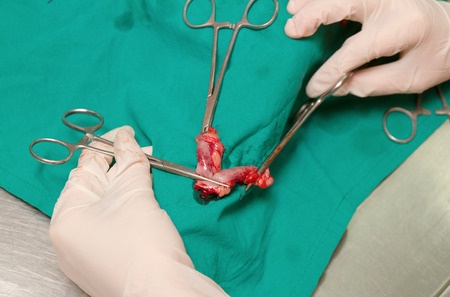Spaying Your Dog

Spaying your dog is another area of controversy in dog circles.
Should you spay or neuter your dog and if so, When?
For most people in the shelter/rescue camp, there is no question. Spaying (female dogs) or neutering (male dogs) is the responsible thing to do. The general mantra of these organizations is to sterilize your dog so they will not contribute to the overpopulation of shelter pets. If you choose not to spay, your pet will suffer all sorts of unwanted health problems.
Radicalized animal welfare folks blame the world’s overpopulation of dogs on breeders—all breeders. They believe that all dogs should be neutered or spayed which would virtually eliminating the need for shelters and rescue groups or pet ownership for that matter. I often wonder where these radical organizations will go for funding if they manage to wipe out the entire world’s pet population.
Spaying and Neutering has become the chant of the entire rescue culture. As the story goes, if more dogs were neutered or spayed, there would not be a population overload at neighborhood shelters. Dogs would not need to be euthanized and all dogs could find a home. How much of it is true, and how much fabricated?
Spay / Neuter Movement
It is true that the pet overpopulation at least in the U.S. has been the main impetuses behind at least 30 years of national and local spay/neuter campaigns. Many campaigners encouraged the early spay/neuter of shelter dogs even before they turned 6 months of age.
Shelters could feel good that the dogs they adopted out would not contribute to the overpopulation. Owners would feel right that their puppies not only would not procreate, but also would be saved from the numerous diseases affecting their intact cousins.
Most people are told that spaying their dog on or before six months of age is all part of being a good pet parent.
This advice sounds so much like a command that puppy owners do not even consider any alternative course. The reason behind this line of thought is that after six months of age, dogs are likely to enter puberty and females may go through their first heat cycle.
Spaying before this time eliminates the hassles of keeping them confined and avoids any mess associated with the heat cycle.
Newer research is showing that spaying your dog may not be the definitive activity that all pet owners engage in when their puppy reaches their 6-month birthday.
Much of what we believe about spaying and neutering dates back to the 1970s, when shelters were being overcrowded. Dogs could not be adopted out so many were euthanized.
To complicate matters more, not all veterinarians agree on the best time to neuter/spay or even to do it at all. Research is available, but not all research is reliable. Take the controversy over early spaying.
Some research has shown that there is an increased risk of joint problems and cancers in dogs that were spayed young. Another research shows just the opposite: There are no problems.
Spaying Your Dog: What is Involved?
 Uterus and Overies Being Removed from a Female Dog
Uterus and Overies Being Removed from a Female DogSpaying your dog (ovariohysterectomy) is a major operation that is done under general anesthesia. The Uterus, Ovaries and fallopian tubes are removed which stops the production of female hormones such as estrogen and progesterone.
- A small incision is made in the abdomen, through
which the organs are removed.
- It is a
routine surgery in most veterinary hospitals and the girls are usually given
some pain medication to ease any discomfort.
(If your girl is not given pain medication, ask for some. Never give Tylenol to dogs).
- The girls will
usually be discharged the same day or the day after surgery. Your dog may not be hungry the first or
second day after surgery and it is a good idea to keep her quiet and calm and
inspect the incision daily.
- There may be sutures that need to be removed after about 7 to 10 days, but recovery is quick and most dogs are up and about soon after they recover from the anesthesia. Most dogs recover without any problems.
Problems That Can Occur After Spaying Your Dog
- Fluid could accumulate under the skin where the incision is located if the dog is too active. If this happens, you will need to take her back to the vet.
- Dogs that insist on licking the incision may need an
Elizabethan collar to prevent this activity.
- Some dogs cough for a day or two after surgery due to being intubated with an endotracheal tube during surgery.
The Canine Heat Cycle
Girls will have their first cycle anywhere between 5 and 12 months of age. Their genitals swell and nipples enlarge. The entire cycle last about 21 days. The first portion of the cycle (1 to 12 days), the dogs produce a bloody discharge that has a distinct odor.
She becomes flirtatious if males are around, and may find ways to go out of the house to explore. A doggie diaper will prevent any mess, but there is nothing you can do about the behavioral aspects of canine heat cycle.
Dogs that normally would never climb over or dig under fences became adept at these gymnastics. Some will find every reason to dart out and wander away, which is a dangerous activity. Even if your girl does not get out, it’s possible that a neighborhood male dog might pick up her scent and come a’ courting.
Once her discharge has changed to clear or ended entirely, she will accept mating by a male, whoever might be available. Heat cycles are repeated every 6 to 9 months throughout the dog’s life.
Advantages of Spaying Your Dog
According to most sources, spaying your dog prevents any unwanted pregnancies. Rescue organizations, shelters, breeders, and veterinarians maintain that neutered pets are healthier, better adjusted and develop closer bonds with their owners than intact dogs. Are there any other advantages to spaying other than birth control?
- There seems to be some evidence that spaying will reduce the risk of mammary tumors, especially if done before the dog goes into heat for the first time.
- One significant benefit of spaying is eliminating the risk of pyometra, a serious uterine infection. There is no chance of uterine or ovarian cancers developing if these organs have been removed.
- There is no chance of false pregnancies, a condition in which the dog’s body tells her she’s pregnant, even when she has not mated.
- You will never need to deal with the mess, odor, and disruptive behaviors that accompany the female heat cycle.
Disadvantages of Spaying Your Dog
- Obesity is a problem in spayed females, so small changes in diet and exercise might need to be made to offset any changes that lack of hormones create.
- Even though spay operations are familiar and routine, it is still a major abdominal surgery requiring general anesthesia. There is always the possibility of complications such as bleeding, infection, and even death. These are rare, but if there are other pre-existing conditions, they have been known to happen.
- There is an increased risk for osteosarcoma or bone cancer in dogs that have been spayed. This is more of a problem in larger breed dogs.
- Both spaying and neutering are associated with cancers of the urinary tract. It is a low risk, but still present.
- There is also a greater risk of hemangiosarcoma or cancer of the blood vessel lining in spayed females.
- There is also some evidence that spaying can increase the possibility of urinary incontinence in female dogs that have been spayed before the age of three months.
- Spayed females also are at risk for developing hypothyroidism.
So, how does one decide what is best for their dog. Begin by examining the advantages and disadvantages of spaying your female dog.
The best advice that I can give to you before you make any decisions is to consult with your veterinarian. He or she will know the risks associated with your breed and can advise you.
Unless there are some underlying health problems that might disqualify your little girl from being spayed, I generally recommend spaying for any dog that is not being used for breeding purposes.
About Janice (author and voice behind this site)
Janice Jones has lived with dogs and cats for most of her life and worked as a veterinary technician for over a decade. She has also been a small-breed dog breeder and rescue advocate and holds academic training in psychology, biology, nursing, and mental health counseling. Her work focuses on helping dog owners make informed, responsible decisions rooted in experience, education, and compassion.
When not writing, reading, or researching dog-related topics, she likes to spend time with her six Shih Tzu dogs, her husband, and her family, as well as knitting and crocheting. She is also the voice behind Miracle Shih Tzu and Smart-Knit-Crocheting
Does This Article Deserve Your Thumbs Up?
We always appreciate your support and encouragement. Your thumbs up means so much to us. Please like this article.
If you find this page or any page on Small Dog Place Helpful, or useful in anyway, I'd love it if you would click the small heart found on the bottom right of each page.
You can also share or bookmark this page -- just click on the:

Free Monthly Newsletter
Sign Up for Our Free Newsletter and get our Free Gift to You.
my E-book, The Top 10 Mistakes People Make When Choosing a Dog (and how to avoid them)

